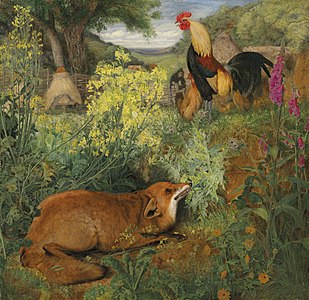William James Webbe

William James Webbe (or Webb) (born July 13, 1830 in
Life
Webbe was born on 13 July 1830 at Redruth, Cornwall, and baptized on the 23rd of that month at St Austell, Cornwall. He was one of eight children of
- Early works, rustic scenes and animals
-
Two lambs in a barn, signed and dated 'W. J. Webb April 1853' (lower left), oil on board
-
Twilight, c. 1855, oil on canvas
-
Rabbit amid Ferns and Flowering Plants, 1855
-
Chanticleer and the Fox, signed with initials and dated 'WJW 1857' (lower left)
Webbe was an early convert to
Webbe is known for his book illustrations for six volumes published by the London publishing house Raphael Tuck & Sons. More of his illustrations can be found in Biblical Stories for Children and in books by authors such as William Makepeace Thackeray and those of his son Wilfred Mark Webb. He drew his book illustrations using the pseudonym WJ Webb.
- Works inspired by the pilgrimage to the Middle East
-
A street in Jerusalem, 1863
-
A Shepherd of Jerusalem, 1863
-
The piping shepherd, signed with monogram and dated '1864' (lower left), oil on canvas
-
A street in Jerusalem, signed with monogram and dated '1867' (lower left)
-
The Homeward Journey, signed and dated 'W.J.Webb/1869' (lower left), oil on panel
William James Webbe was living in the Isle of Wight in 1856, later, in 1861, he resided at Langham Chambers, "in an area where many of the Pre-Raphaelites congregated and had their studios".[4] According to Webbe's great great grandniece, Jennie Shelley, "In the 1901 census William aged 70 and his wife Besse aged 52 were living at 4 Marlborough Rd, Ealing, Middlesex, and his occupation was artist. Also at that address was his daughter Ethel who was a science mistress." His brothers, Samuel Webb and Thomas Stirrup Webb, emigrated to New Zealand. Samuel was a pottery manufacturer in Stoke on Trent, William's mother, Sarah Stirrup, also "came from generations of pottery manufacturers".[2]
Reception

John Ruskin briefly commented on The White Owl, exhibited at the Royal Academy in 1856, in his Academy Notes: "A careful study — the brown wing excellent. The softness of an owl's feathers is perhaps inimitable; but I think the breast might have come nearer the mark."[5][1]
There are two versions of The White Owl painting; one was sold at Sotheby's Belgravia on 14 June 1977 (lot 31) and bought by the Fine Art Society, the second one is owned by
Webbe's work A street in Jerusalem (1867) received mixed reviews. His contemporary art critic Tom Taylor of the Times wrote: "[the painting] is treated in the most realistic spirit ...but the composition seems to us too crowded for the canvas, and there is an abuse of bright colour...it may be that the critic in this cold, grey north is not competent to pass judgement on eastern colour ...for Mr Webbe's clever and careful Street in Jerusalem".[6]
Works

- A Hedge Bank in May, 1855
- Twilight, c. 1855
- Cattle and a Fram, 1856
- The White Owl, 1856
- Strawberries, 1860
- Lambs, 1860
- The Collared Thief, 1860
- Early Lambs, 1861
- A Rabbit, 1862
- Street in Jerusalem, 1863
- Ploughing on Mount Zion, 1864
- The Lost Sheep, 1864
- A White Terrier by a Mossy Bank with Flowers, 1871
- A Plough Team outside Jerusalem, 1879
- Perch on a River Bank
Book illustrations

- 6 books printed by Raphael Tuck and Sons:
- The 23rd Psalm
- The Influence Of Beauty by Keats
- Feld Blumen (poetry in German)
- Bluen Botschaft (poetry in German)
- Homes Of England by Felicia Hemans
- The Sower And The Seed by Helen Marion Burnside
- Other books for adults:
- The Holiday Train by Frederick Longbridge
- The History of Samuel Titmarsh and the Great Hoggarty Diamond. A Little Dinner at Timmins's and Notes of a Journey from Cornhill to Grand Cairo by William Makepeace Thackeray, Smith, Elder & Co., London, 1879
- The Childrens Friend, 1893
- Eton Nature-Study And Observational Lessons (2 volumes) by M.D. Hill and Wilfred Mark Webb
- The Heritage of Dress. Being Notes on the History and Evolution of Clothes by Wilfred Mark Webb, The Times Book Club, London, 1912
- Illustrated Natural History by W. G. Ridewood, Richard Tuck, London, 1902
- The Friendly Visitor
- Bible stories for children:
- Bible Stories And Pictures by James Weston
- Bible Pictures And Stories (New Testament) by James Weston
- Bible Pictures And Stories (Old and New Testament)
- The Beautiful Story
- Charming Bible Stories
- Young Folks Story Of The Bible
- Old Testament Stories by Robert Tuck
Notes
- White English Terrier was established as an official breed in the early 1860s and became popular as a show dog. Renowned for its alertness, the breed quickly became extinct after 1895 when cropping of the ears was outlawed and interest in the breed waned."[7]
References
- ^ a b c d e f g "William James Webbe (fl.1853-1878)". www.christies.com. Retrieved 8 November 2021.
- ^ a b c "William James Webbe, 1830—1904[?]: An Overview". victorianweb.org. Retrieved 7 November 2021.
- ^ "William James Webbe, Victorian Art History". avictorian.com. Retrieved 7 November 2021.
- ^ "William James Webb". Sutcliffe Galleries. Retrieved 7 November 2021.
- ^ "The White Owl by William J. Webbe". victorianweb.org. Retrieved 8 November 2021.
- ^ "Bonhams : William J. Webb (Webbe) (British, active 1853-1878) A street in Jerusalem". www.bonhams.com. Retrieved 10 November 2021.
- ^ "A White Terrier by a Mossy Bank with Flowers". emuseum.toledomuseum.org. Retrieved 8 November 2021.









